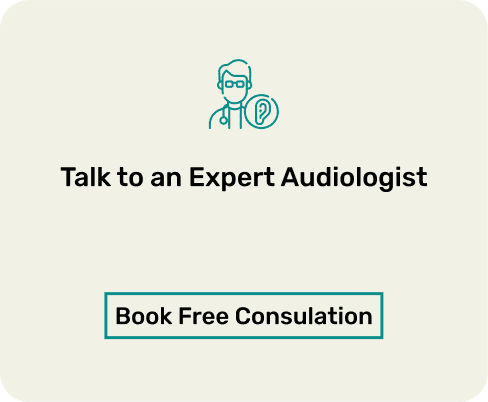Pure Tone Audiometry test (PTA) is a simple yet decisive hearing test in India that reveals what your ears can truly detect, beyond what you might realise you’re missing in everyday life.
We also cover what happens during the test and where you can have it done in North India – Delhi, Gurgaon, Dwarka, Chandigarh, Jalandhar, Ludhiana, Patiala, Pathankot, and more.
What is the Pure Tone Audiometry Test and How Does It Measure Hearing?
So, what is the PTA test?
Pure tone audiometry measures the faintest tones a person can hear at different pitches or frequencies.
Think of it as testing the full range of your hearing—from the low, deep sounds (like a tuba) to high-pitched sounds (like a bird chirping).
During the hearing test, you will listen through headphones as the audiologist plays a series of beeps and tones at various frequencies, gradually decreasing the volume until you can no longer hear them.
Each ear is tested separately, and the results create a visual representation called an audiogram—essentially a graph that maps your hearing thresholds in decibels (dB) across different frequencies measured in hertz (Hz).
This helps identify whether hearing loss exists and its specific pattern and severity, which is crucial for proper treatment planning.
Who performs a PTA hearing assessment?
In India, expert audiologists are qualified to perform a Pure Tone Audiometry (PTA) hearing test in India. They are usually certified by the Rehabilitation Council of India (RCI).
When Should You Consider a Pure Tone Audiometry Test for Hearing Evaluation?
You might want to consider booking a pure tone audiometry test if you’ve noticed:
- Social Strain: Friends and family commenting that you’re missing parts of conversations
- Repeated Clarification: Finding yourself saying “pardon?” more often than you used to
- Listening Fatigue: Feeling exhausted after social gatherings because listening feels like hard work
- Volume Issues: Turning up the telly volume to levels that others find too loud
- Persistent Tinnitus: A ringing or buzzing in your ears that won’t go away
Hearing care experts typically recommend regular hearing checks:
- Under 50: Once every 3-5 years if you’re under 50 with no hearing concerns
- Over 50: Every 1-3 years after age 50
- Special Circumstances: Sooner if you’ve had an ear infection, head injury, or work in noisy environments
Early detection through audiometry can significantly improve treatment outcomes for hearing loss, making regular screening an important part of your healthcare routine.
Pure Tone Audiometry: Step-by-Step Testing Process
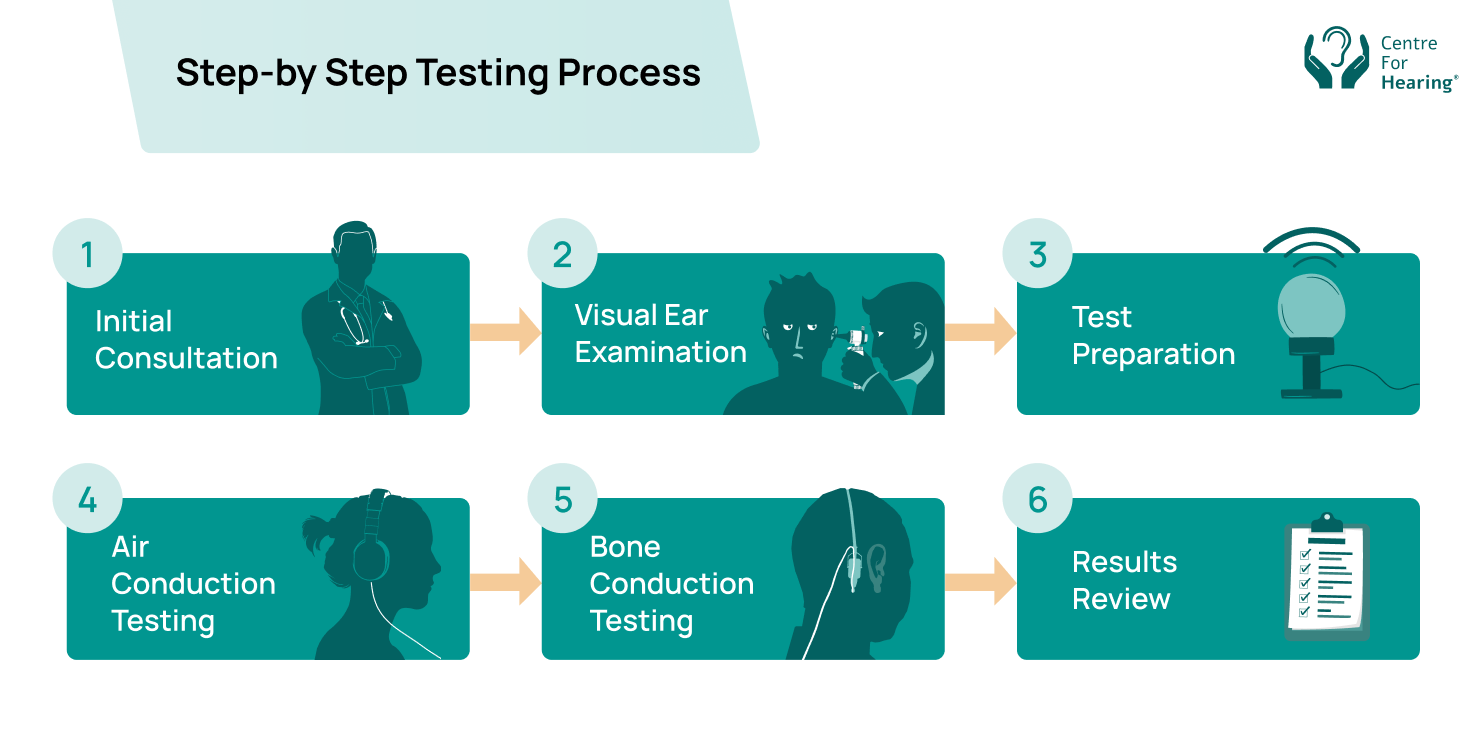
Rest assured, having a pure tone audiometry (PTA) test takes about 20-30 minutes, and many people find it quite interesting to discover the range of sounds they can detect. There’s no need to “pass” or “fail” – it’s simply about mapping your unique hearing profile.
Here’s exactly what happens:
Step 1: Initial Consultation
Your audiologist will begin with a friendly chat about your hearing concerns and health history. This helps us understand your specific situation and any particular difficulties you may be experiencing.
Step 2: Visual Ear Examination
They will use an otoscope (a small torch-like instrument) to take a quick peek in your ears to ensure everything looks clear and there are no blockages that might affect your test results.
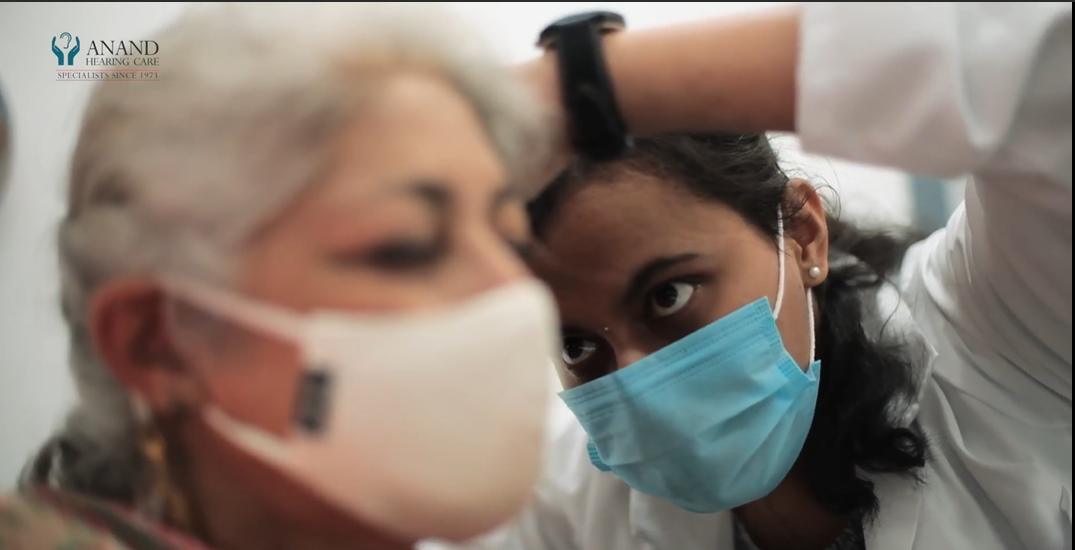
Step 3: Test Preparation
You’ll be seated comfortably in our sound-treated room – a quiet space designed to keep outside noise from interfering with your test results. Your audiologist will explain the testing process and how to indicate when you hear sounds.
Step 4: Air Conduction Testing
Wearing headphones, you’ll listen for a series of tones of varying pitch and volume. You’ll simply press a button or raise your hand whenever you hear something, even if it’s incredibly faint. This measures how well sound travels through your ear canal and middle ear.
Step 5: Bone Conduction Testing
A small vibrating device will be placed behind your ear (on the mastoid bone) to test how your inner ear responds to sound. This helps distinguish between different types of hearing loss by bypassing the outer and middle ear.
Step 6: Results Review
Your audiologist will compile your results into an audiogram – your personal hearing map – and explain what it means in practical, everyday terms.
Pure Tone Audiometry Test: Understand the Result of Your Audiogram
An audiogram is a graph that shows your hearing.
- X-axis (horizontal): Sound frequencies (pitch), ranging from low (250 Hz) to high (8000 Hz).
- Y-axis (vertical): Sound intensity (loudness), measured in decibels (dB), ranging from very soft (-10 dB) to very loud (120 dB).
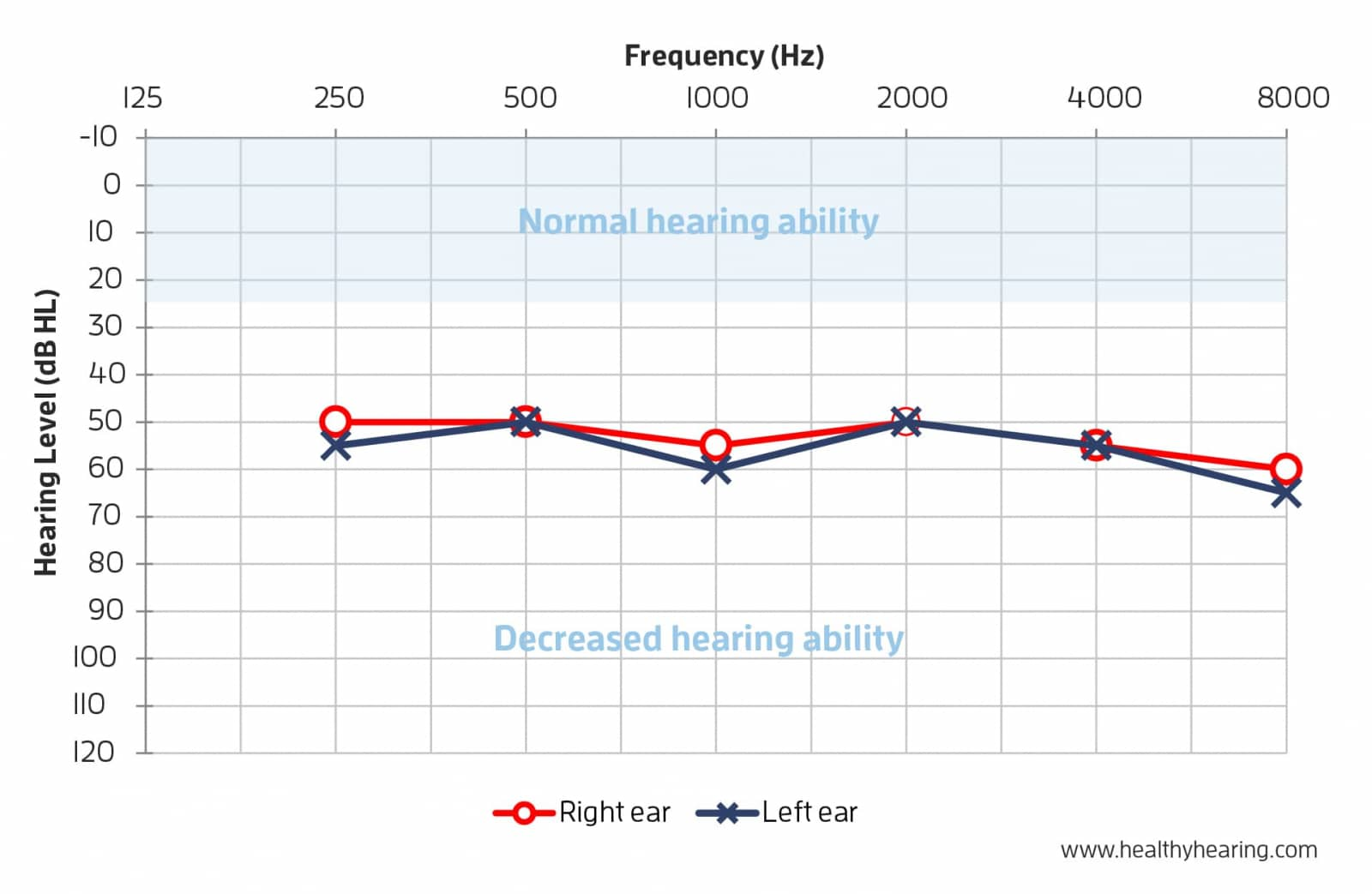
Source: Healthyhearing.com
Severity (Degree) of Hearing Loss
The degree of hearing loss may be categorised as one or a combination of the following:
You can see the degrees of hearing loss shown pictorially near the audiogram below.
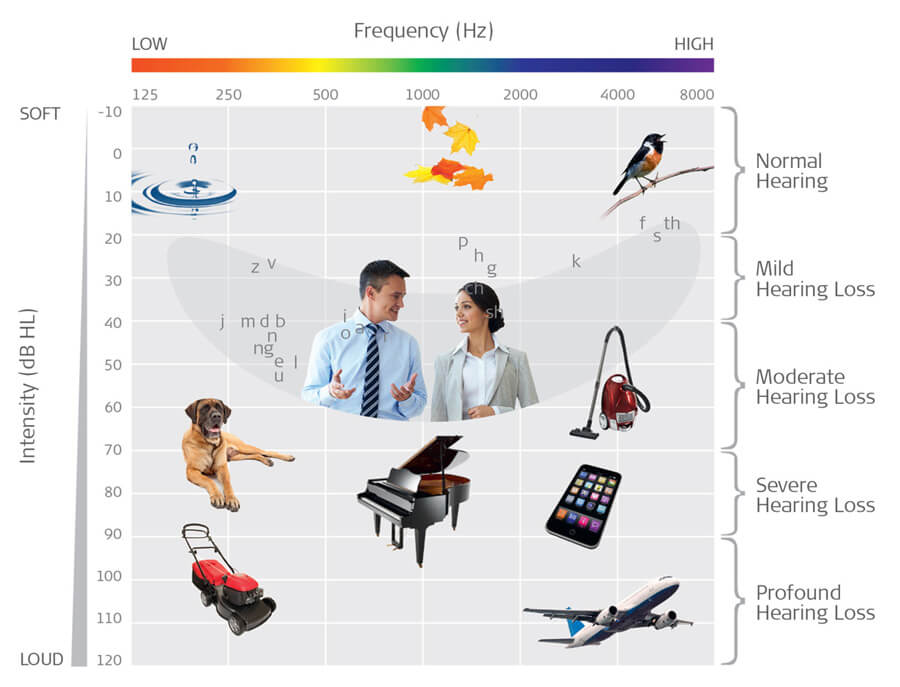
Where does normal spoken speech lie on this audiogram?
The grey “speech banana” shape shown on the audiogram represents the range of normal conversational speech across different frequencies and intensities. Most speech sounds fall between 250 Hz and 6000 Hz in frequency, and between 20 dB and 60 dB in intensity (loudness).
This includes a wide variety of sounds:
- Vowels (e.g., “a”, “e”, “o”) are typically lower in frequency and louder, making them easier to hear.
- Consonants (e.g., “s”, “f”, “th”, “k”) are higher in frequency and softer, which is why people with high-frequency hearing loss may say they can hear but not understand speech clearly.
Understanding where speech lies on the audiogram helps in diagnosing the impact of hearing loss on everyday communication.
For instance, someone with mild hearing loss may miss softer consonants, while those with moderate or greater loss may struggle with full word recognition even in quiet environments.
Where to Get Professional Pure Tone Audiometry in Delhi NCR
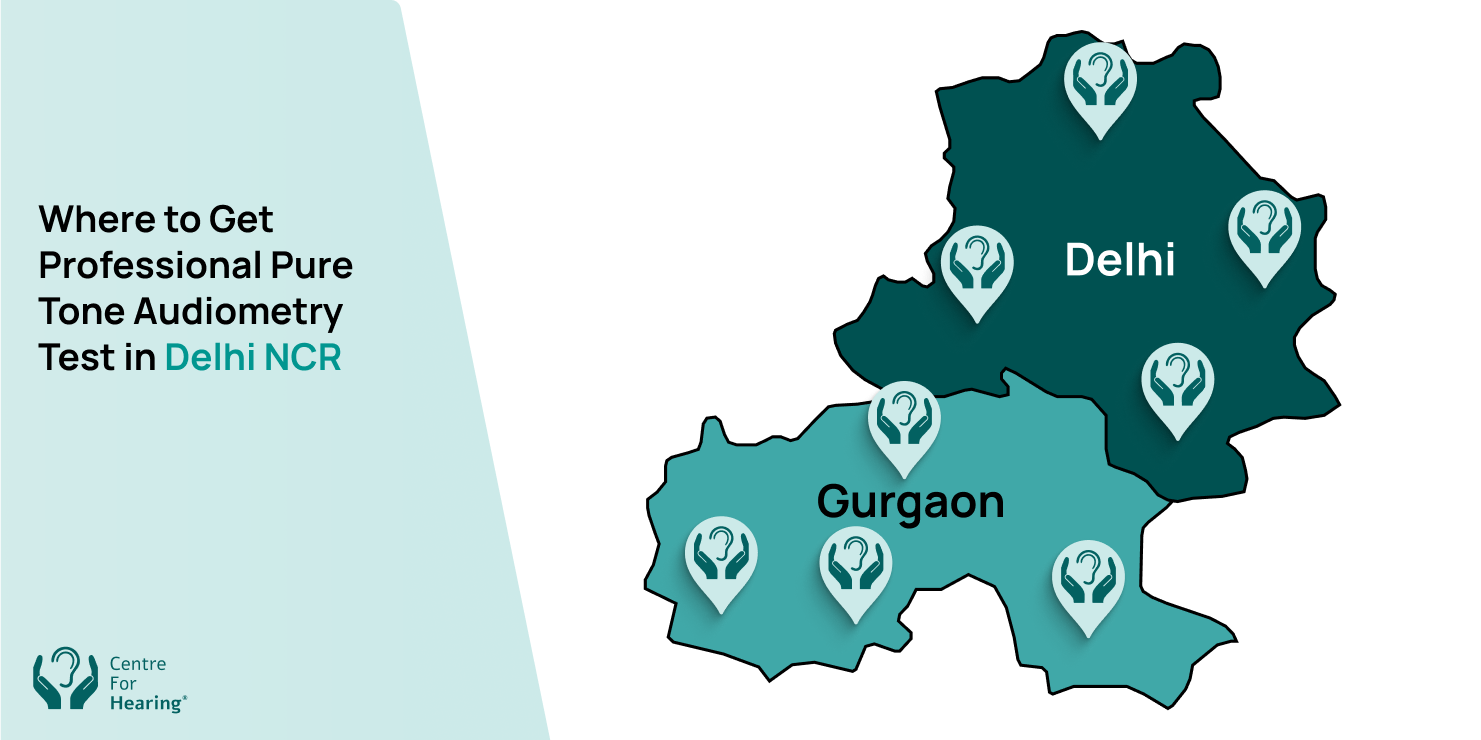
At Centre for Hearing®, one of the best hearing care and audiology clinics in India, we pride ourselves on providing top-notch, patient-centred care alongside clinical excellence.
Our clinics offer top-notch audiometry tests in Delhi NCR in comfortable, welcoming environments where you’ll never feel rushed.
Searching for “PTA test near me”? You’ll find our centres in:
- Delhi – Central: Old Rajender Nagar (Shankar Road)
- Delhi – North: Gujranwala Town (near Model Town Metro)
- Delhi – South: Green Park
- Dwarka: Manipal Hospital (Palam Vihar)
- Gurugram: DLF Phase IV (Sector 43)
- Gurugram: Sector 49 (Eros City Square)
- Gurugram: Palam Vihar (Manipal Hospital)
We also have a centre in Chandigarh (Sector 20-D) serving patients in the region.
You can also locate your nearest facility here.
Our testing rooms are properly sound-treated (much quieter than a library!), and our equipment is regularly calibrated to ensure accurate results. Most importantly, our audiologists take the time to explain everything clearly.
To book an appointment, simply give us a ring at 9811227269 or email us at care@centreforhearing.org.
Pure Tone Audiometry Test Cost and Pricing in India
Centre for Hearing® provides transparent pricing for pure tone audiometry testing:
- Delhi: Rs. 800
- Chandigarh: Rs. 1,000
- Punjab: Rs. 800
This fee includes the complete assessment (both air and bone conduction testing), a detailed audiogram, and a consultation with our audiologist to explain your results and answer any questions.
We offer various payment options, and many insurance providers cover audiometric testing when medically indicated.
For patients requiring additional assessments beyond basic audiometry, we offer comprehensive diagnostic packages that include multiple tests at competitive rates.
We also have the world’s top hearing aid brands at exciting discounts.
Call or WhatsApp us on 9811 227269 to learn more.
FAQs
1. How long does a pure tone audiometry test take to complete?
A standard test typically takes 20-30 minutes to complete. The appointment length may be slightly longer to include initial paperwork, ear examination, and post-test consultation about your results.
2. Is pure tone audiometry painful or uncomfortable?
It is completely painless and generally comfortable. The test simply involves listening for tones through headphones and indicating when you hear them. The sound levels are controlled and never reach uncomfortable volumes that could harm your hearing.
3. How often should I get a pure tone audiometry test done?
Adults with no hearing concerns should have a baseline test, then follow-up tests every 3-5 years until age 50, and every 1-3 years thereafter. Those with existing hearing loss, family history of hearing problems, or regular noise exposure should be tested annually.
4. What’s the difference between pure tone audiometry (PTA) and speech audiometry?
This measures your ability to hear tones at different pitches and volumes, while speech audiometry assesses how well you understand speech at different volumes. Both tests are often performed together for a comprehensive hearing evaluation.
5. Can children undergo pure tone audiometry testing?
Yes, children as young as 3-4 years can usually participate in modified pure tone audiometry testing. For younger children who cannot reliably respond to traditional methods, specialists use observational techniques and age-appropriate versions of the test to assess hearing ability.
6. Will I need to remove my hearing aids for a pure tone audiometry (PTA) test?
Yes, hearing aids must be removed during audiometry to accurately measure your natural hearing thresholds. However, if you wear hearing aids, your audiologist may also perform additional tests to evaluate how well you hear with your devices in place. This is known as an Aided Audiometry Test.
7. How accurate is pure tone audiometry in detecting different types of hearing loss?
The test is highly accurate and is considered the gold standard for identifying hearing loss. It can reliably detect conductive, sensorineural, and mixed hearing loss patterns.
For maximum accuracy, testing should be performed in a sound-treated environment by a qualified audiologist using properly calibrated equipment—all standards maintained at Centre for Hearing® facilities.
8. As a pilot, I need a hearing test in India. Where should I go?
Hearing tests for pilots are performed at any of Centre for Hearing® ’s clinics in the country. Call 9811227269 to schedule an appointment.
9. Where can I have a NABH/ NABL-accredited PTA hearing test done in Delhi?
Private or standalone hearing care centres are not accredited for NABH or NABL. Should you need a NABH or NABL-certified report, you would need to visit a certified hospital. Manipal Hospitals in Dwarka or Palam Vihar, Gurugram, are good options for these in Delhi NCR.
Call 9811227269 to schedule an appointment.
Final Note
Pure tone audiometry is more than just a hearing test—it’s your window into understanding how you connect with the world around you. The sounds of laughter, cherished conversations, and life’s meaningful moments deserve to be heard clearly.
With a simple 30-minute test, you can take the first step toward preserving or reclaiming these precious auditory experiences.
We’d love to welcome you to Centre for Hearing®. Our caring team is here to help you understand your hearing health and explore options if needed.
͏Our exp͏er͏t hearing care ser͏vice͏s are available across ͏India: Mumbai, Gurgaon, Delhi, Punjab (Ludhiana, Patiala, Jalandhar, Chandigarh Tricity – Chandigarh, Mohali, Panchkula).
To book your ͏free consultation today, you can call us ͏at +91 9811227͏2͏69 or email us at care@ce͏ntrefor͏hearing.com.



